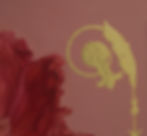
SPRING
2021 - 2022 | oil and gold leaf on canvas | canvas size 37 x 48 cm | 14.5" x 18.9" | with frame 52 x 62 cm | 20.5" x 24.4"
«[...] [E]rweitert sich der Raum in unserem Innern […] werden [wir] zuletzt selbst zu einer großen Blume, wo sich alle Gestalten und Gedanken wie Blätter in einem großen Stern um das Tiefste unserer Seele, um den Kelch wie um einen tiefen Brunnen drängen, aus welchem bloß die Staubfäden als die Eimer und die tiefen Leidenschaften unserer lebendigen Seele herauskommen und wir uns selbst immer verständlicher werden »
« As the space in ourselves expands we ourselves become at last a great flower, within which all shapes and thoughts crowd like leaves in a great star around the depths of our souls, gathering around it’s calyx as if it was a deep well, out of which come only the filaments as the buckets and the deepest desires of our living souls and we grow to understand ourselves more and more »
These words were written in 1803 by the german artist Philipp Otto Runge in a letter to his mother, describing the ideas behind his series The Times, depicting the times of day from morning till night, as well as the seasons and stages of life from birth to death. In his letter he is paralleling growing self-awareness with the blossoming of a flower in spring, and by using the words « at last » implies how to him spring is the climax of life’s journey and the last one in the season’s cycle. He specifies how « […] in the manners of the artist spring should always be the last, the season of bloom, which emerges rescued from destruction […] » - the lost primal state of innocence, not as a return to infancy but as a return to the state of humanity before the biblical fall of man.
The psychoanalytical counterpart to this theory has been defined as individuation process (Individuationsprozess) by the psychoanalyst Carl Gustav Jung in the early 20th century and describes it as a means of becoming whole (Ganzwerdung). As the seasons recur in never ending cycles, humans are supposed to surmount their own mental blockages by ceaselessly questioning and challenging themselves to reach their full potential. This process requires a certain willingness to self-sacrifice, since the Self has to ongoingly be broken up (killed) in order to arise in a higher form from it's own ashes. In the christian sense, this journey is portrayed in the ordeals of christ and his crucifixion, after which he arose again in his purified, unbodily astral form - his apotheosis and ensuing return to god. Unlike in the linear christian reading, the process is made into a cycle by it's equation with the blossoming of a flower and the season of spring - implying how life is an iteration branded with many sacrifices and metaphorical deaths in a continuous effort to grow.

This ordeal and the following growth as an inward-principle is mirrored in the ancient philosophies of Alchemy as the step of Nigredo, in which the Self has to be transformed in the black fire of depression in order to be destroyed, dissolved, split-up, humbled and melted in the fire. In this spiritual death the soul is lifted up into the heavens. While the body remains bound to the ground, spirit and heart dwell in a higher realm and all thoughts and deeds are said to be divine. The many different steps and deaths in alchemical texts make clear that those are not literal but metaphorical deaths, as a requirement for change and growth.
In the painting Spring painted between 2021 and 2022 this idea of resurrection and sacrifice - as a means for psychological and spiritual growth - has been depicted in the humanoid figure of the tulip. While the blossoming flower-head is what draws the viewers immediate attention, the meaning of the painting reveals itself in the details on the hands. The crucifixion-marks on the wrists are placed where contemporary scholars believe the nails were placed on Christ. The red marks just below indicate the placement of the robes that supported the weight of his body on the cross. The hands are placed on a manner that recalls byzantine Icons, a recurring source of inspiration for the artist, and serve to subtly showcase the marks. These sinister details add a layer of brutality and violence to the otherwise delicate depiction of the figure, it's floral form and the soft, transparent veil that surrounds it's body, covering the lace top with the butterfly-shaped lace collar. This 2011 Haute Couture dress by Valentino has been picked to underline the fragility of the - otherwise genderless - figure and the feminine properties of fertility associated with flowers in bloom. The gilded neoclassical ornaments on the sides in front of the monochrome rose-colored background symbolise the artificiality of the subject and its placement in an otherworldly, purely symbolical realm. The gold furthermore traditionally symbolises divinity. The rounded upper corners align with the gilded 19th century picture frame, which the artist used as a base for the composition. These frames have historically been reserved for sacred imagery, especially depictions of the virgin Mary, sometimes shown carrying the infant Christ.

2021 - 2022 | oil on canvas | 37 x 48 cm | 14.5" x 18.9" | tulle and lace couture gown Valentino Haute Couture 2018

2021 - 2022 | oil on canvas | 37 x 48 cm | 14.5" x 18.9" | tulle and lace couture gown Valentino Haute Couture 2018

upper right corner with gilded ornament | 2021 - 2022 | oil on canvas | 37 x 48 cm | 14.5" x 18.9"

2021 - 2022 | oil on canvas | 37 x 48 cm | 14.5" x 18.9" | tulle and lace couture gown Valentino Haute Couture 2018